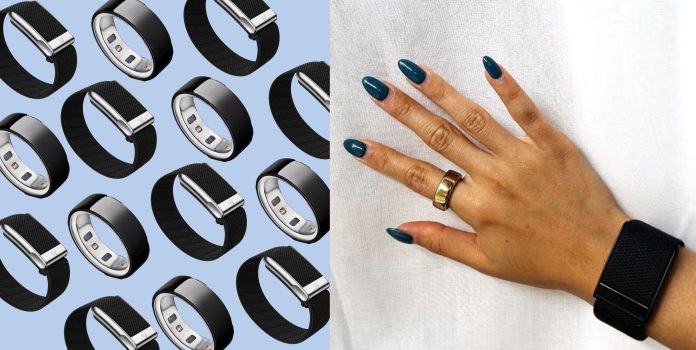I realized a couple of years ago that my lifestyle choices could best be described as “voluntarily guzzling an awful cocktail of stress, five hours of sleep, skipping breakfast, and unbalanced hormones on the reg,” and since then, I’ve been on a journey of testing out a variety of health trackers to get all of that (*gestures wildly*) back on track. And after spending months testing the Oura Ring and the Apple Watch for your reading pleasure, I knew it was time to take things to the next level with a Very Serious Gadget—the WHOOP, a screen-free health and fitness tracker worn by Sha’Carri Richardson, Michael Phelps, Shohei Ohtani, Cristiano Ronaldo, LeBron James, and tons of other pro athletes. Even my 16-year-old brother loves his!
So, inspired by him and this slew of very sporty people, I tested the Gen 4 Oura Ring vs. the WHOOP 5.0 for 3 months to give you alllll the details on the great, the good, and the not-so-good.
My first impressions

The Oura Ring in Gold on my left pointer finger.

The WHOOP on my left wrist.
The Oura Ring is (obviously) a ring, whereas the WHOOP is a small, flat device that you wear on a wrist band. Each connects to a respective app where you can see the data that the device gathers throughout the day. I found that it takes a lot longer for the WHOOP app to sync up with the device (unless you keep Bluetooth on at all times) because there’s just so much info to digest—especially after a night of sleep—whereas the Oura app updated more quickly. It was to the point where I thought my WHOOP had died overnight because I didn’t see any data… until I got a notification 20 minutes later that my sleep stats had processed. Clearly I could work on my patience.
The Oura app to be super easy to use—every morning, you’ll wake up to four scores (Sleep, Activity, Readiness, and Resilience) that summarize your data from the previous day, along with some helpful charts and guides. The WHOOP app interface is a little harder to navigate at first, but that’s purely because it’s so chock-full of information. With the level of detail you get, it’s clear the WHOOP app is ideal for anyone who is ready to deep-dive into their biometrics.
Here are the exact models that I wore for the testing period:
Ease of wear
I’ve been known to rave about how easy the Oura ring is to style—it looks like an elegant piece of jewelry, especially if you get silver or gold. It blends seamlessly with the rest of my rings and accessories, and I often forget I’m wearing it because it’s so light and unobstructive.
The WHOOP wristband is a little harder to style in a subtle way because it’s set on a thicker black band by default, but the device can actually be worn on your bicep, on your waistband, etc if you’d prefer to ditch the band! You can purchase a variety of accessories, from sports bras and boxer shorts to arm sleeves, that have a little slot to insert your WHOOP device.
not a fan of the band? try these alternate options instead!
How’s the battery life?
The Oura Ring and the WHOOP both last forever. I can use both devices for multiple days and nights before needing to top off the battery, and as someone who often forgets to charge her devices, I love that both wearables makes my life easier—not harder.
Oh, and one bonus feature that I love about the WHOOP—you charge it with a clip-on battery pack that’s basically a portable charger. You can even charge your WHOOP as you’re wearing it, so technically you can wear it 24/7 and never have to take it off (meaning you’ll have continuous data!).
Sleep tracking
If there’s one thing that convinces you to invest in the WHOOP or the Oura Ring, let it be the sleep-tracking feature. Both monitor how sleep efficiency, nighttime breathing, how long you spent in each type of sleep (like REM or deep sleep), and if you woke up throughout the night. The Oura app grades your sleep with a handy score (0-100) each morning whereas the WHOOP app will give you a sleep performance percentage (0-100%) that’s basically how much sleep you got compared to how much sleep you actually needed.
But there’s one feature that gives the WHOOP a leg up: the sleep debt calculator. The app informs you how much sleep you should’ve gotten based on your current stats, how much sleep you actually got, and how many hours of missed sleep you’ve accumulated (!!!!) throughout the week.
This feature ended up being totally eye-opening. For example, there was one morning when my Oura app told me that my readiness score and sleep score were both through the roof—and to be fair, they were! I felt great and had gotten some great sleep. But a look at my WHOOP data revealed that I’d actually accumulated so much sleep debt throughout that week that I actually needed one more hour of sleep than I got.

The sleep section on the Oura app

The sleep section of the WHOOP app
Oh, and if you aren’t sold yet—the Oura Ring and the WHOOP are great devices for checking to see whether any lifestyle changes you make lead to a noticeable difference in your sleep or not. For example, I noticed some breathing disturbances being tracked on both apps, so I cleaned out my AC filter (it was gross) and started running the Jaspr Pro air purifier in my apartment. While that didn’t fix the issue completely, I did notice a slight increase in my sleep scores as a result! I live in a high-pollution city so there’s a pretty good chance that better indoor air contributed to that uptick.
Fitness tracking
I’ve said this before, and I’ll say it again—the Oura Ring is an excellent smart ring that tracks steps, heart rate, activity, and caloric burn, but it’s not *primarily* a fitness tracker. Sometimes it recognizes activities I’m doing (like boxing or climbing stairs) but other times, it asks me if I spent 10 minutes dancing when I was really sprinting for the train.
The WHOOP, on the other hand, has been co-signed by SO many athletes (although to be fair, the resilience and recovery functions of the Oura Ring are also helpful for training). The WHOOP is great at automatically detecting what you’re doing—like, I went kayaking one weekend and my WHOOP logged the activity as well as how long I spent in each cardio zone out on the water and exactly how strenuous it was.

My weekly strain levels in the WHOOP app—clearly, I work a desk job.
The strain feature is unique to WHOOP—it calculates how much stress you’re putting on your body throughout the day. Strain between 0 to 5.9 is considered resting, 6 to 9.9 is considered light, 10 to 13.9 is considered moderate, 14 to 17.9 is considered high (think making gains at the gym) and 18 to 21 is considered significant stress (this is typically difficult to recover from).
WHOOP also offers a VO2 Max estimation, which is basically the maximum amount of oxygen your body is able to use during exercise. A higher VO2 Max = higher cardio abilities, so it’s a good way of measuring one aspect of fitness. Your VO2 Max score updates every week—and of course, listen to your body above all, no matter what your numbers say!
Cycle tracking
Okay, we’re about to get a little technical, but stay with me here. An easy way to keep tabs on your cycle is to track your temperature, which fluctuates throughout the month. You can wake up and manually take your temperature at the same time each morning, or you can use a device that takes accurate readings for you! Obviously, I’d prefer the latter.
The Oura Ring takes your temperature as you’re sleeping and then uses it to track the ebb and flow of it throughout your cycle with predicted ovulation dates and potential period start dates. Oura partners with Natural Cycles, an FDA-approved form of birth control, to confirm your fertility status and current cycle phase. I had nooooo idea what was going on with my body before I started using the Oura Ring, but now I can tell when I’m about to get my period based on a noticeable drop in my temp. Crazy, huh?
The WHOOP also offers a form of cycle tracking. I LOVE that the app tells me my current strain tolerance based on your cycle, so I can make plans accordingly (aka cancel my workouts when I’m about to get my period). But overall, it’s a less seamless experience. The WHOOP monitors overnight skin temperature and you can manually enter menstruation in your daily journal, but the cycle feature seems like a bit more of an afterthought and it just isn’t as easy to keep track of your cycle status throughout the month. They also aren’t an FDA-approved form of tracking fertility.

The Oura app, where you can track body temperature, cycle phase and day, and estimated period dates.

The WHOOP app, where you can use the journal feature to track menstruation, ovulation, pregnancy, etc.
Pricing
The Oura Gen 4 ring ranges from $349 to $499, depending on the color you choose. The membership that gives you access to the app costs $5.99/month after your first month free.
The WHOOP bands cost anywhere from $0 to $99—the black band is free with your purchase of a membership, which costs between $199 to $359/year.
It’s not a perfect comparison, but although the Oura ring has a little bit more of an upfront cost it’ll end up being more affordable in the long run. That annual WHOOP membership can really add up over time, honestly—but it all comes down to your personal budget and preference!
shop the Oura ring and the WHOOP here!
So, what’s the final verdict?
Y’all, this is a hard one. Some would even say it’s a toss-up. After testing both for three months , I can confidently say that both are excellent devices that provide great biometric insights. Could you wear both at the same time? Absolutely, especially if you’re down to get suuuper granular about your health. But you probably only need to invest in one, so here’s a breakdown of some of the reasons you might find yourself leaning one way or another.
Reasons to get the WHOOP over the Oura Ring
- Very detailed fitness and biometric insights
- Monitors strain levels, cardio zones, VO2 Max, muscular load, etc
- In-depth sleep tracking with sleep debt calculations
- Offers custom plans for improving sleep, maintaining consistency, etc.
- A great pick for gym-goers, loved by professional athletes
- Can be worn on the wrist, bicep, or waistband
- Can create a team with your friends who own WHOOPs
- Receive one month free for every friend you refer
Reasons to get the Oura Ring over the WHOOP
- Gorgeous colorways, looks like expensive jewelry
- Lightweight and lowkey—it doesn’t look like you’re wearing a fitness device!
- Measures your resilience and stress levels
- Sums up lots of complicated data into daily scores
- Offers the Symptom Radar tracking to pick up on potential sickness
- In-depth menstrual cycle tracking
- Excellent step tracking
- Can be paired with Natural Cycles
- Offers guided breathwork, sleep tracks, and meditation
- Can create a Circle with your friends who own Oura Rings
Why trust us?
As Cosmo’s tech expert, shopping editor Hannah Oh has spent months testing various health trackers and wearable devices like the Oura Ring, the Apple Watch, the Fitbit, and the WHOOP. She takes her sleep and wellness very seriously (eight hours each night or bust!) and spends her free time explaining to her friends and family why they should hop on the biometrics train.
Hannah is the Shopping Editor at Cosmopolitan, covering all things from chic home decor to trendy fashion finds, TikTok products that are actually worth your $$$, and the perfect gift to buy for your boyfriend’s mom. She previously wrote for Seventeen and CR Fashion Book. Follow her on Instagram for hot takes on red carpet fashion and pictures of her office outfits that nobody asked for.

















